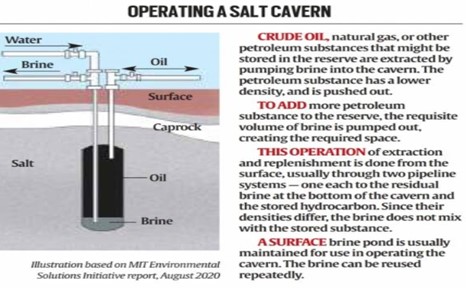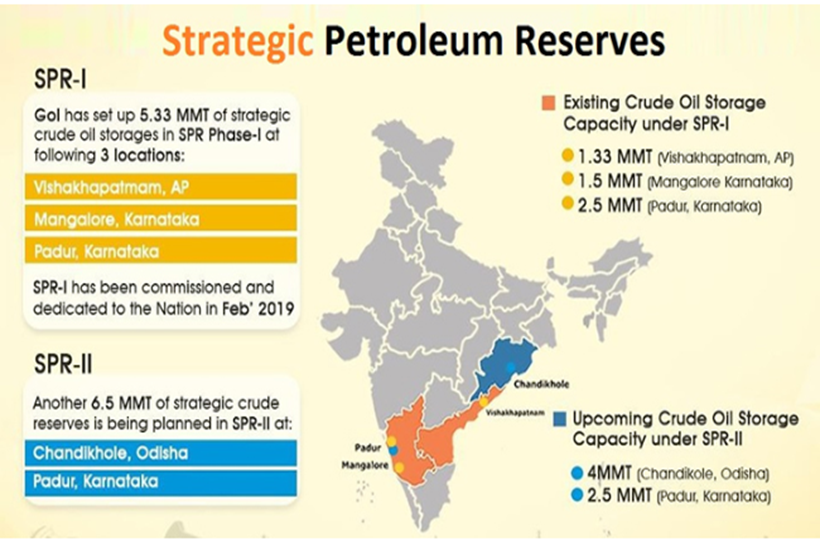- Courses
- GS Full Course 1 Year
- GS Full Course 2 Year
- GS Full Course 3 Year
- GS Full Course Till Selection
- Answer Alpha: Mains 2025 Mentorship
- MEP (Mains Enrichment Programme) Data, Facts
- Essay Target – 150+ Marks
- Online Program
- GS Recorded Course
- Polity
- Geography
- Economy
- Ancient, Medieval and Art & Culture AMAC
- Modern India, Post Independence & World History
- Environment
- Governance
- Science & Technology
- International Relations and Internal Security
- Disaster Management
- Ethics
- NCERT Current Affairs
- Indian Society and Social Issue
- NCERT- Science and Technology
- NCERT - Geography
- NCERT - Ancient History
- NCERT- World History
- NCERT Modern History
- CSAT
- 5 LAYERED ARJUNA Mentorship
- Public Administration Optional
- ABOUT US
- OUR TOPPERS
- TEST SERIES
- FREE STUDY MATERIAL
- VIDEOS
- CONTACT US
SALT CAVERN BASED OIL RESERVES
SALT CAVERN BASED OIL RESERVES
05-06-2023


Latest Context
Engineers India Ltd. (EIL), a government-owned engineering consultancy, is researching the advantages and feasibility of developing Rajasthan's salt cavern-based strategic oil reserves.
- The government's goal of enhancing the nation's strategic oil storage capacity is aligned with the research.
What is Salt Cavern-based Reserves?
- Solution mining is the process used to dissolve salt in water to create salt caverns, which are underground spaces.
- With this method, water is pumped into locations with significant salt deposits in order to dissolve the salt and form caverns. These caverns can be used to store crude oil once the brine (water containing dissolved salt) has been taken out.
Rock Based Cavern:
- Excavated rock-based caverns for oil reserves are underground spaces created by manually excavating and removing rock materials to form large storage cavities.
- Drilling, blasting, and rock layer removal are used to create the desired storage space in excavated rock caverns. The rock walls and ceilings of these caverns serve as the natural barriers for containing the stored oil.
Importance of Salt Based-Cavern Over Rock Based Cavern:
- Developing salt cavern is easier, faster, and cheaper. Salt cavern-based oil reservoirs are inherently closed and designed for efficient oil injection and extraction.
- A report from MIT's Environmental Solutions Initiative suggests that storing oil in salt cavern is more favourable than storing it in other geological formations.
- The very low oil absorbency of the salt that lines the caverns makes it naturally impermeable to liquid and gaseous hydrocarbons. Salt caverns are ideal for oil storage due to this property.
- The largest emergency oil storage in the world, the Strategic Petroleum Reserve (SPR) of the United States, is entirely dependent on salt cavern-based facilities.
Potential of Salt Based Cavern:
- India's SPR story may get a new, much-needed chapter thanks to salt cavern-based storage, which is thought to be less expensive than rock caverns and requires less labor and money than salt caverns.
- With its abundance of salt formations, Rajasthan is thought to be the best place in India to build salt cavern-based strategic storage facilities.
- The infrastructure is ideal for developing strategic oil reserves due to the presence of crude oil pipelines in Rajasthan and a refinery in Barmer.
Issues to Build a Salt Based Cavern for Oil Reserves
- Indian companies haven't had the technical expertise-how to build strategic storage facilities in salt caverns.
- To close this knowledge gap, EIL has recently formed a partnership with a German company that specializes in solution mining and cavern storage technology.
- It is essential to locate suitable locations for salt cavern-based storage facilities. While Rajasthan has bountiful salt formations and favourable infrastructure, for example, crude pipelines and a new refinery in Barmer, explicit destinations inside the region should be surveyed for their geological and technical suitability.
- Until the technology and expertise required to construct salt cavern-based storage facilities are obtained, it will be difficult to estimate the project's cost. Preparation of the site, construction, and operational aspects must all be taken into consideration, as must additionally costs.
What exactly is the Strategic Petroleum Reserves (SPR) Programme of India?
- Indian Strategic Petroleum Reserves Limited (ISPRL) is in charge of overseeing the building of the strategic crude oil storage facilities in India.
- ISPRL is an entirely owned subsidiary of Oil Industry Development Board (OIDB) under the Ministry of Petroleum & Natural Gas.
- According to Phase I, there are strategic crude oil storage facilities at Mangalore (Karnataka), Visakhapatnam (Andhra Pradesh), and Padur (Karnataka). They have a total 5. 33 MMT (million metric tonnes) of fuel storage.
Extra Reserves under the PPP:
- As part of phase II, the Indian government intends to construct two more similar caverns through public-private partnerships, one each at Chandikhol (Odisha) and Udupi (Karnataka). The oil reserves will increase by 6.5 million tonnes as a result.
- A total of 22 days (10+12) of oil usage will be made available once the new facilities are operational.

Capacity/Industrial Stock:
- Indian refiners also keep 65 days’ worth of industrial stock of crude oil at their strategic facilities.
- As a result, when Phase II of the SPR plan is finished, India will have access to enough oil to last for around 87 days (22 days from strategic reserves plus 65 days from Indian refiners).
- This will be quite close to the IEA's 90-day requirement.
- India joined the IEA as an associate member in 2017 and was most recently extended an invitation to join the organisation permanently.
Need to Increase SPR's Capacity:
- India, the third-largest consumer of crude in the world, imports more than 85% of what it needs, thus SPR can assist assure energy security and availability in times of emergency and supply shocks throughout the world.
- At two locations, Chandikhol in Odisha (4 million tonnes) and Padur (2.5 million tonnes), India is now enlarging its SPR capacity by a total of 6.5 million tonnes.
- The current SPR capacity of India is 5.33 million tonnes, or around 39 million barrels of oil, which can supply the country's needs for 9.5 days.
Way Forward
- It is essential to carry out thorough geological and technological evaluations of possible locations in Rajasthan.
- A thorough feasibility analysis will be helpful in determining the project's economic and technological viability. To establish the viability of salt cavern-based storage facilities, this study should examine possible hazards, project deadlines, operating requirements, and long-term sustainability.
- Exploring public-private partnerships can aid in lowering government expenditures and attract private investment towards the creation of strategic reserves. Partnerships that take use of the reserves' commercial potential can increase the project's viability and contribute to economic growth.



